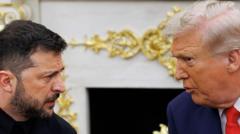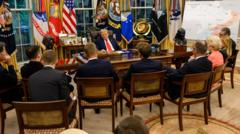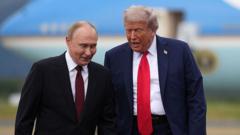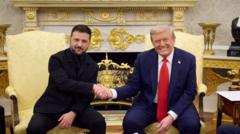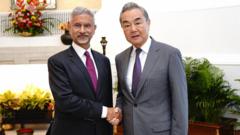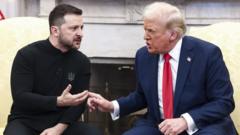President Trump has signed an executive order to effectuate parts of the recent UK-US tariff deal, which reduces certain tariffs on British goods but maintains levies on UK steel. The agreement has sparked debate over its implications for both countries' industries.
Trump Finalizes UK-US Tariff Agreement Amid Ongoing Trade Tensions

Trump Finalizes UK-US Tariff Agreement Amid Ongoing Trade Tensions
The newly signed tariff deal aims to reduce trade barriers between the UK and US, yet includes ongoing tariffs on key imports.
President Donald Trump has signed an executive order to implement certain components of the recently negotiated tariff deal between the UK and the US. The agreement primarily focuses on reducing trade barriers, particularly concerning British cars being shipped to American markets. As part of the deal, up to 100,000 vehicles will now be subjected to a 10% tariff, significantly lower than the previous 25% import tax imposed on all vehicles. Despite this reduction, the pact continues to attract criticism for the absence of measures addressing the steel tariffs that remain in effect.
During the G7 summit in Canada, UK Prime Minister Sir Keir Starmer dubbed the signing a "very important day" for trade relations between the two nations. The tariff deal emerged after intensive negotiations aimed at protecting British interests from the repercussions of Trump’s broader trade policies, which have raised tariffs on a wide range of imports as a way of encouraging American-made goods. The initial talks culminated in last month's agreement, marking the first such announcement from the White House following its implementation of tariffs on various imports earlier in the year.
While the 10% levy on UK cars has been hailed as a relief for automobile manufacturers, uncertainty looms over the steel and aluminum tariffs. Trump remarked that steel imports would soon be addressed, although specific details remain undisclosed. As it stands, UK imports of steel and aluminum are currently subjected to a 25% tariff, which the UK government is attempting to reduce, signaling an ongoing negotiation process.
Trade representatives and business leaders have voiced their concerns about the clarity and implications of the agreement. Gareth Stace from UK Steel has emphasized the need for further clarification regarding import quotas, as existing regulations state that steel must be "melted and poured" domestically to qualify for exemptions.
The agreement additionally includes concessions allowing tariff-free access for a quota of US ethanol into the UK, previously hindered by a 19% tariff. This move faces scrutiny from UK producers, who fear job cuts if the local market is not safeguarded.
While the government promotes the tariff agreement as part of broader trade negotiations with the EU and India, critics argue that the deal falls short of a comprehensive trade agreement and represents a constrained effort in addressing key trade issues. Opposition parties in the UK have labeled the final deal as merely a "tiny tariff deal," suggesting a need for greater transparency on its impact, particularly on British agriculture and industry standards.
In conclusion, as both nations work to refine their trade relationship, clarifying the stipulations and outcomes of this tariff agreement remains critical for stakeholders in the automotive and steel sectors.


